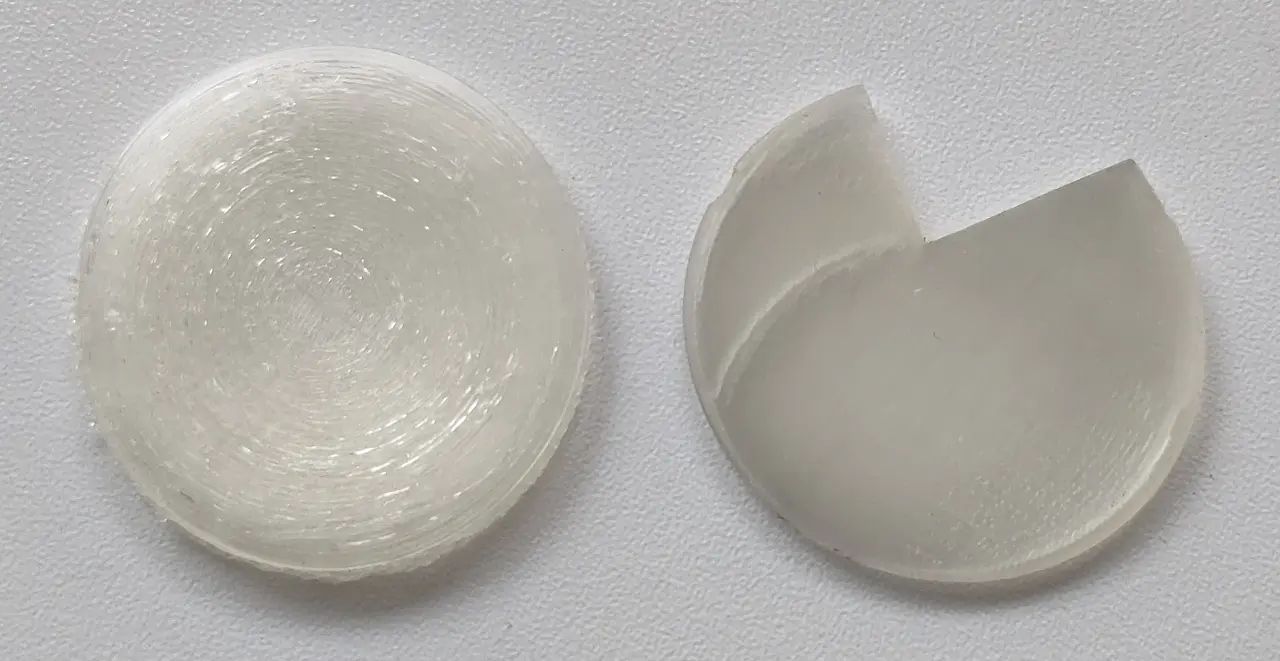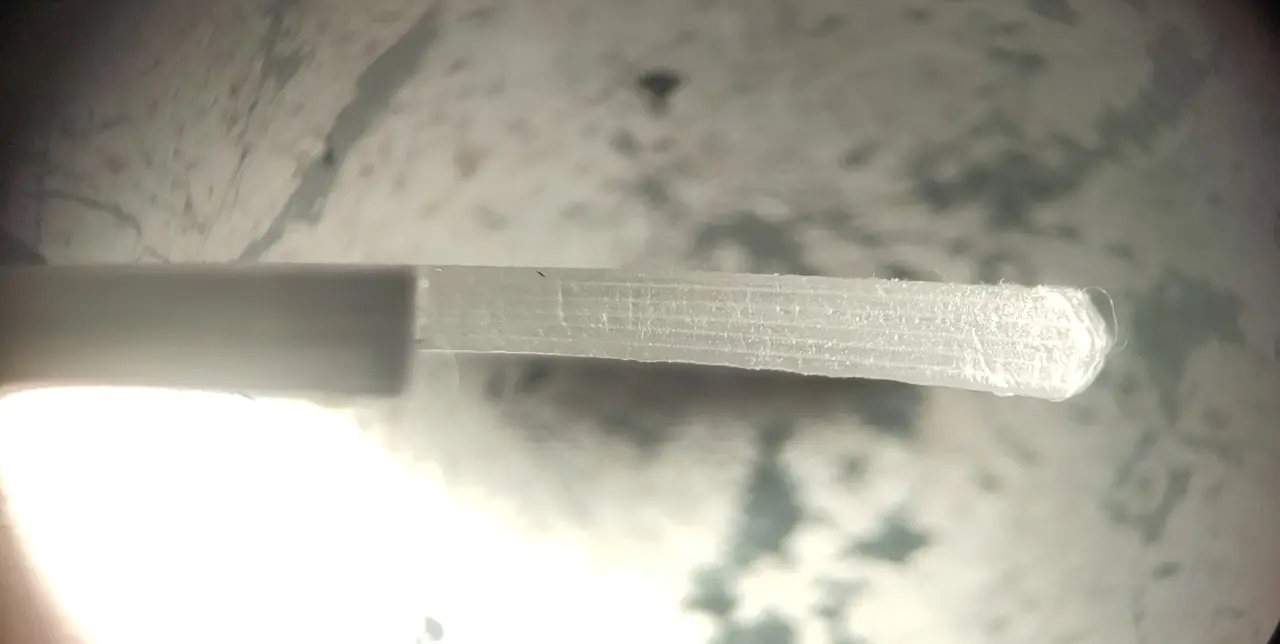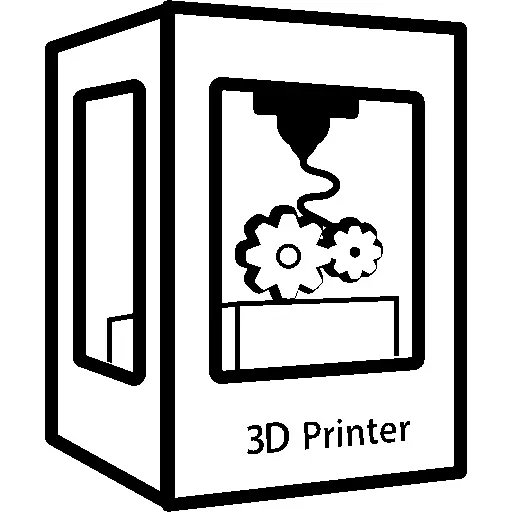In the process of refining the design for my 3D printed glasses (yes, I’m still at it 🙂) and trying to streamline the lens ordering process a bit, because some folks have told me their optician, or their optician’s lens supplier, didn’t really want to mess with “unusual” things like this, I decided to draw and print a fake ophthalmic lens. You know, not optical-quality - or even see-through - but something that looks and feels like a lens, that can be mounted in my frames, to show an optician hands-on how it works and that it’s not weird or delicate to work on.
I figured it would be a quick print in clear PLA, that would require only a bit of cleanup and mount right into the frames, complete with the bevel and the notch and everything. How wrong I was…
This part is almost impossible to print right:
-
It’s modeled after a real bispherical lens with an offset optical axis. I mean it’s optically incorrect, but it has everything a real lens would have: uneven edge thickness, one convex and one concave side.
You just can’t set it flat on the bed in the slicer: none of it sits flat. The slicer has trouble generating support around the edge on the concave side that it interprets half of as overhang, and even if the beginning of the support doesn’t get ripped off by the head and the print completes, the surfaces will be absolutely awful.
-
If you print it vertical - which frankly is the least bad option - then the bottom of the lens, under the support, will be a complete mess. The bevel won’t even be visible. It takes quite some time to create supports that won’t mess up the bottom of the lens too much
-
If you print it in clear PLA with only perimeters, it’ll be transparent enough to see the spots were the perimeters are started at the next layer. And depending on your wall generation strategy, the spots where the printer tries to fill the voids will show up as round “halos” inside the lens.
The lens’ thickness varies everywhere, so the slicer tries its best to fill each layer, but it’s slightly different at every layer. At any rate, it reveals the slicer’s idiosyncracies in tool path stragegy right away.
-
The bevel all around the lens is only 0.5mm high. If the printer is dialed in, the bevel will show as an actual 120-degree bevel near the front face of the lens, particular where the bevel is normal to the layer, about half-way up the lens if you print it vertically. If not, it will look like a barely-raised blob.
I’ve tried this print on 3 different printer and I just can’t get a decent print. All I can do is play with the settings in the slicer until it comes out not too terrible.
So, that part is a bit frustrating for my original purpose, but it turns out to be a great part to test a printer and/or the slicer software! If you want to try it too, it’s here:
https://github.com/Giraut/3D-printed_eyeglasses/raw/refs/heads/main/lens_example.3mf




A part like this is begging to be done on a resin machine. You can’t beat them for the kind of shapes and tolerances you’re working with here.
I’d give it a go on my FDM machine, but I have .8 nozzles loaded right now - no hope haha.
I’d be happy to turn a few of these out in resin if you don’t have a machine, would only ask for the freight cost.
Thanks for the offer! But actually I didn’t model that part for me but for others who need a model of a finished lens. I already have real lenses myself.
The thing is, I shared the design of my glasses for others who might want to print themselves the same glasses too, and there seems to be enough interest that some folks printed them and went to their opticians with it, only to be turned away because the frames are unusual - or they didn’t want to risk having lenses made using the lens template only to find out that the lenses are unusable in the final frames - and they didn’t want to risk filing a notch in the lenses either, which is something that’s not usually done to fit lenses to frames.
And I can understand the opticians too: if they agree to order lenses and they don’t fit the frame, the loss is on them and they don’t need the aggravation.
I wanted to provide a model of a lens that those folks could print out of PLA to convince the opticians that it’s not sketchy or far-fetched. If this parts needs a resin machine - which, I agree with you, it absolutely looks like it does if you really want a quality part - then it sort of defeats the point of self-sufficiency of my little project.
Sounds like the eventual end. Will be learning how to take raw circler optical lenses. As the optical centres do. And build the tools for folks to shape them at home.
Such a project would be a huge advantage to many 3rd world environments. And would likely be about embedding quality glass cutting blades etc into 3d printed frames/mechanisms. Likely from PA. With the ability to embed metal rods and gears where stability, strength is needed.
It’s a guess ut I imagine the issue you have. Is most commercial opticians just see this as less option for them to sell overpriced frames. So agreeing to shape lenes for frames they dont sell. Is just a way to support the end of their profit line.
In the UK, when we started seeing the Chinese companies selling online glasses. We had lots of opticians refusing to give copies of the RX. Or limiting the positioning info they give. As all that part is NHS funded. Laws helped. But without legal force, companies ain’t going to help themselves lose business if it is obvious.
You’re welcome - glad to see you have it really sussed out. Finding something that works for you and knowing it won’t just up and disappear off the market (as many fashion frames do) is excellent.
Can see the optician side as well - they have an established process and deviating from that is unwanted faff. However, they are perfectly capable of ordering a lens to a customer given spec. A short ‘if this doesn’t work then lol you suck’ disclaimer is all it would take to make the sale.
Resin is well within reach of the casual hobbyist now - we’re talking a couple hundred dollars to get an entry level machine, and a little extra coin for the materials/consumables. I have a (now old) Mars 3 that is ticking along beautifully.
Safety/PPE/ventilation is the main downside compared to FDM. It’s a stinky job but you can’t fault the results for presentable and functional parts. These things can print stuff like screw threads and other teensy features perfectly.
Offer always stands if you ever want something to demo and can’t get anyone more local to help :)
I am very tempted by a resin printer. However - and this is going to sound weird - I actually like the limitations of FDM.
And this is why: I’m a hacker at heart (in the old sense, not the nasty illegal stuff) and I like to push the envelope of what our Prusa Mk4 printer can do. I’ve printed stuff with that thing that I had no right to print by working the workarounds in the model, playing with layer sizes and controlling the path of the nozzle so it ends up printing features that are right at the limit of what it can do. Hell, even the hinges in those specs of mine are kind of pushing it.
And it’s fun! It provides hours of good fun trying this or that and finally getting the little printer to print something right.
A resin printer would make very good prints without anything to do, if that makes sense 🙂
Also I want to work with different materials. I’m actually looking into getting a Prusa XL with several heads to combine TPU for flexible, hollow parts and PLA for the supports inside the parts. That’s something a resin printer can’t do: resin printers print… well, resin.
And finally, I’m always kind of designing parts with a view to making it available to anybody who has any old printer at home for them to print and enjoy. That approach entails designing for the lowest comon denominator (to a reasonable degree), something a resin printer is not.
So you see, while I would like a resin printer, I feel it’s just not the right printer for me.
Can’t argue with that. I still use FDM as well for a lot of models - currently running an old Ultimaker 2 and a BCN3D Sigma D25 for the bigger batch jobs.
The latter is mostly stock but the UM2 is pretty much unrecognisable from when it was new now; a real Ship of Theseus. Bigger gantry, uprated board/head/feeder and tweaked Tinker firmware to suit. Shoved a Pi with Octoprint in there too.
While you can get flex & specialty resins, you are right that you’re certainly not printing them alongside the regular stuff in one run like you intend to, unless the model is redesigned in multiple parts. They are also priced to suit :|
Will be good to see what you come up with. Almost all of my prints are the work of others these days. I’m not much of a designer and the furthest I go with CAD is putting terribleness together in a 12 year old version of Sketchup 😂
If you really want entry-level, the Geeetech Alkaid is regularly on sale for $99 and I’ve had one for a couple of years and it’s fine. I’m not aware of anything it’s missing versus more expensive entry-level SLA printers, but no one seems to be aware it exists. Nearly all the problems seem to be because it’s full of Chitu hardware and runs Chitu firmware, but that’s true of nearly everything cheapish.
I wasn’t aware until you told me, so that holds true. Might pick one up, that’s cheap enough just for funsies.
I’ve not had a problem with the Chitu breed of kit - hardware or software. But I have seen some absolute horror stories from the later Mars machines. The 4 MAX (maybe the whole 4 series) has a fantastic bug where leaving the USB in while turning on will trigger the machine to start a firmware update.
A bit of a hitch when it doesn’t check for firmware files being present first before wiping itself. Making the mistake of leaving the USB in at power-on effectively soft-bricks it.
Elegoo are now leaning into moving vats, which is fancy and allows for autolevelling. I think it’s just a recipe for trouble and more parts to fail though.
I think the main draw of a moving vat is that you can tilt it during the film-part separation, so it concentrates the peel force in a line that passes over the part instead of having it spread over the whole thing and needing more force which could warp the part or stretch the film. That should mean you can get away with replacing the film less often. If the film isn’t replaced often enough, it can make the print quality worse, or tear and leak resin into the printer where all the LEDs are, which will kill the printer.
I think all Elegoo’s machines have at least some Chitu guts, and Chitu-free machines tend to make that their main selling point (and also cost a chunk more than equivalent Chitu-based ones).
The other point here is that if the lenses a user gets don’t quite match the frame you could always just tweak and reprint the frame a bit to match the lenses. That’s not really the end of the world, but I don’t count on any opticians to understand that. The concept of a user being able to so easily self manufacture a set of frames is probably completely alien to them.
Oh believe me, they understand perfectly.
Here’s the thing - and I’m not inventing this: my current optician is a friend and she told me this verbatim: an optician’s bread and butter is selling you frames, and the services around fitting the lenses on the frame and fitting the frame on you. Opticians make almost no money on the lenses - which they have made abroad in developing countries usually.
I don’t deny that there’s a lot of measuring prior to ordering lenses, counselling the customer, and then a lot of fiddling with the temples and the nose pads after the glasses are completed to make sure the glasses are comfortable and yada-yada. The services provided by opticians are definitely useful, particularly for young wearers and for people who change frames often.
But really, if you’re a lifelong glasses wearer, you’re reasonably handy and you settle on one frame geometry, those measurements never change and you just don’t need the services.
Me, the last time I needed an optician’s services was over 20 years ago when I made my first frames out of nickel silver. Since then, I’ve only made copies of those exact frames because I really like them - including those 3D-printed ones I drew a few weeks ago: they’re a bit different to account for the nature of the 3D-printing process, but the key measurements are the same.
So whenever I go to an optician to order new lenses - which you almost have to because you can’t order the lenses direct, even if you have all the measurements needed by the lens maker, the convo always goes something like this:
I kid you not, it’s extortion. They hate it when you can do their job yourself so they charge you for the privilege. And since you don’t have access to their suppliers (they look out for each other) you have to go through them.